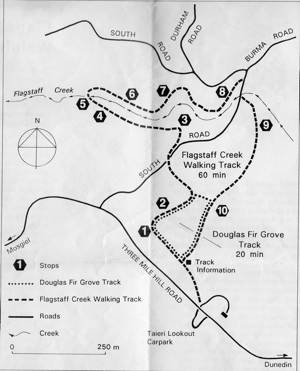Sir Truby King, a man of many parts, was for some 31 years superintendent of amental hospital at the village of Seacliff. The setting was superb, but the enterprise got off to the worst possible start. A magnificent-looking series of stone buildings was designed by R A Lawson, whose commission was at the time the largest ever paid in the colony. In Scottish Baronial style, the three-storeyed Oamaru-stone buildings were modelled on the Norwich County Asylum in England, with a 50m tower. Criticism was not limited to the design – day-rooms received little sun, bedroom windows were too high to see the view, and for the 1,273 doors there was an embarrassing diversity of keys. The very foundations proved woefully inadequate for the notoriously unstable site. Not long after the £78,000 contract had been completed, a royal commission was set up which criticised both architect and builder. For all the outcries through the years over the unsafe nature of the buildings, it was not until 1972, nearly a century later, that the last of the patients were finally evacuated to Cherry Farm.
King transformed into a hospital a place the public had hitherto regarded as a gaol. After he became superintendent in 1888, patients were given outside work, greater liberty and more exercise. The use of violence by warders was banned. The Seacliff farm flourished and King’s careful attention to livestock and seed selection drew the resentment of neighbouring farmers who envied his success at A & P shows. Poultry was raised and in 1903 the patients began a fishing enterprise that fed the asylum twice a week and supplied other institutions throughout the South Island. Even attentive to staff, Truby King emulated Johnny Jones in buying land and helping them to finance their own homes. It was while King was at Seacliff that he recognised the importance of nutrition both for mental patients and, as an adjunct to his rearing of cattle, for children.
The asylum’s most notable inmate was Lionel Terry (1847-1952), an Englishman educated at Eton and Oxford who tramped the country in 1901 lecturing on the perils of New Zealand being taken over by the Chinese. In his book of poetry, The Shadow, he extolled the virtues of “pure … unpolluted northern blood” and saw in the quiet industry of the Chinese a subtle attempt to conquer the country by weakening the Anglo-Saxons with “luxury and idleness”. His book did not sell well. On learning this he made his point more dramatically by walking the streets of Wellington to find and shoot an elderly Chinese, who, he reasoned, was too old to care much about living anyway. He promptly confessed and wrote to the Governor complaining of “alien invaders”. Terry tapped an extensive well of anti-Chinese resentment and his trial caused a sensation. His sentence to death in 1905 was commuted to one of ife imprisonment and he was removed here after setting fire to the gaol at Lyttelton. He escaped on numerous occasions, to be fed, clothed and concealed by his many admirers, some 50,000 of whom signed a petition for his release. Finally King offered Terry a degree of liberty conditional on his not escaping again, terms he accepted for the rest of his life. At the time of his death here in 1952 he wore long flowing robes and long flowing hair, and was convinced he was the second Messiah. (Some of Terry’s poems are in the museum at Waikouaiti.)

